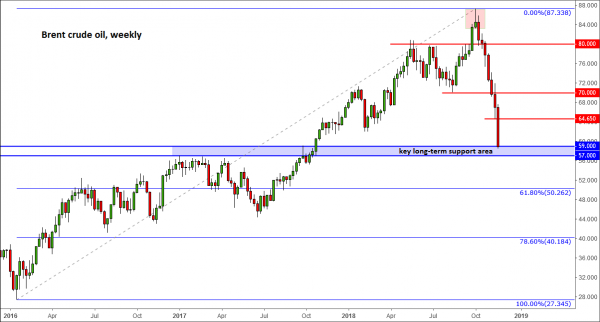This holiday shortened trading week did not put off speculators from being heavily engaged in the markets, as volatility remained elevated.
It was literally a “Black Friday sale” for crude oil, which fell more than 6% at one stage with Brent dipping below $58.50 amid concerns Saudi Arabia won’t be able to cut crude supply due to pressure from Donald Trump to keep prices low. But we think that oil prices may have fallen too far, too fast. Thus, a short-covering rebound is increasingly likely soon, possibly in early next week, especially as Brent is now at a long term support area in the $57-$59 region – see the chart below.
Bitcoin and other cryptocurrencies also had a week to forget, as sentiment continues to deteriorate towards digital currencies. The stricter regulatory environment and momentum is giving the bears the sort of opportunities the bulls were enjoying last year.
However, the immediate focus will be on Brexit. Spanish objections over Gibraltar remain among a few sticking points as the UK is seeking to finalise its exit deal with the EU. An EU summit will take place this weekend to approve the Draft Withdrawal agreement. Ahead of this, the UK Prime Minister, Theresa May, once again refused to say whether she will quit if parliament votes against her Brexit deal next month.
Meanwhile, the economic calendar will be a lot busier next week.
New Zealand retail sales will come out first thing Monday. This will be a quarterly figure (as is the case for most of NZ’s key data releases), so it should have a meaningful impact on the kiwi should the actual figure deviate significantly from +1.0% expected. Then, once Europe gets underway, we will have the German Ifo Business Climate, which is a closely-watched survey of about 7,000 businesses, asking respondents to rate current business conditions and expectations for the next 6 months. So, let’s see if recent events (EM currency crises, trade wars etc.) have dented sentiment among manufacturers, builders, wholesalers, services and retailers.
In mid-week, we will have several important economic pointers from the US. The CB Consumer Confidence is released on Tuesday; preliminary US GDP will be published on Wednesday and a few other second-tier macro pointers will come out on Thursday – including core PCE price index, personal spending and pending home sales, as well as the Fed’s last meeting minutes.
A couple of Federal Reserve members have already expressed concerns about these risks last week and hinted at the prospects of slower rate hikes going forward. Meanwhile, inflationary pressures stemming from the crude oil market should also be weakening given the big falls for Brent and WTI amid concerns over excessive supply and slower demand growth for the black stuff. This is an additional reason why the Fed may decide against hiking aggressively next year. If we indeed do see further dovish commentary from Fed members then the dollar could start to head lower.
Friday will see the release of Chinese manufacturing PMI as well as some not-so-important Japanese pointers. The Chinese PMI will be watched closely as investors try to gauge the economic impact of the nation’s trade dispute with the US. Also on Friday, we will have German retail sales and Eurozone CPI, and Canadian GDP.
So, there’s plenty to look forward to next, which should mean more volatility and hopefully even better trading opportunities.


 Signal2forex.com - Best Forex robots and signals
Signal2forex.com - Best Forex robots and signals




